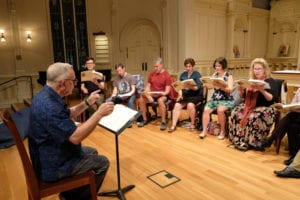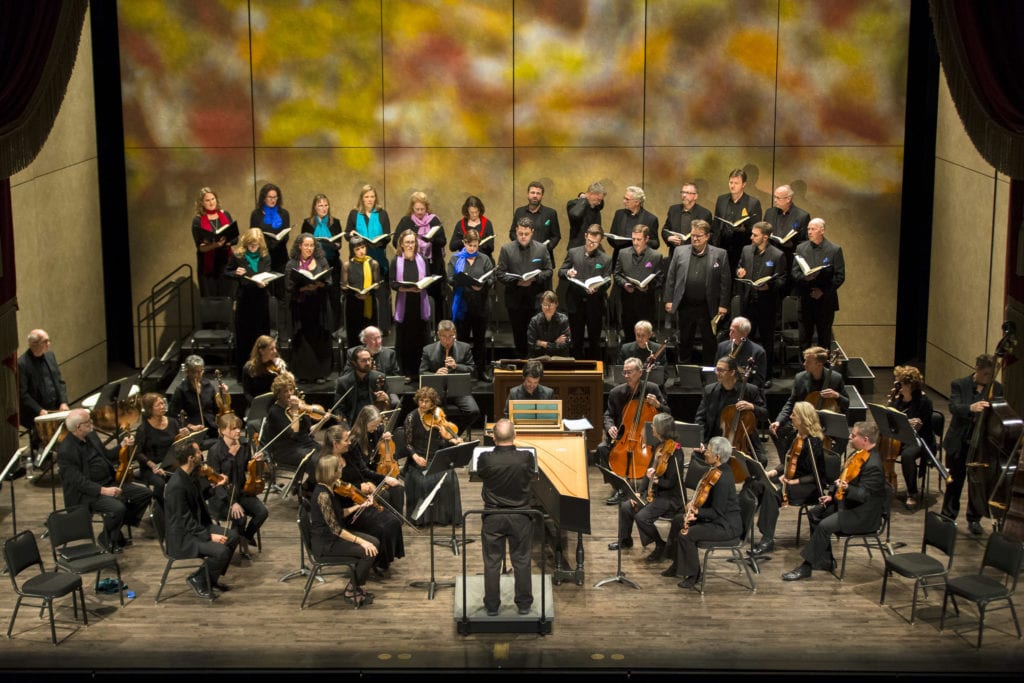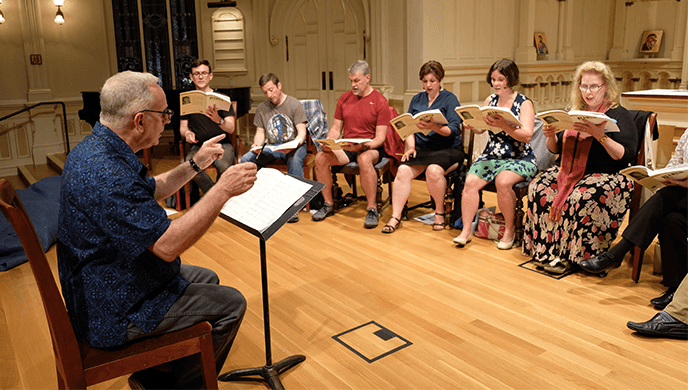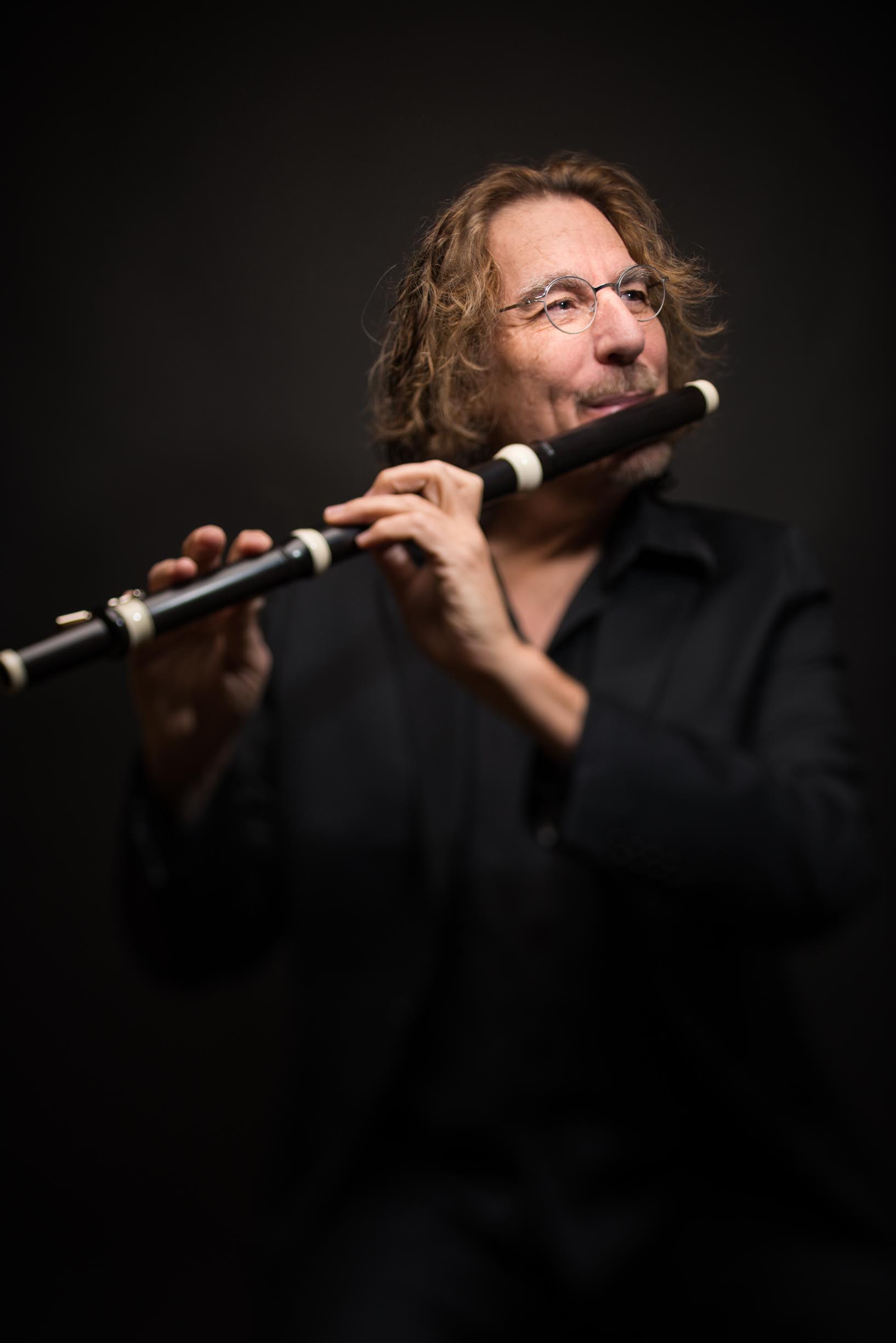The Complete Chorale Singer
By Bruce Lamott
Philharmonia’s recent addition of “and Chorale” to its moniker had more significance than a mere change of logo. It was rather a recognition that we expect the same synergy of technique, expression, and historically informed performance from our 24-voice professional vocal ensemble as we do our instrumentalists. The Chorale is specially selected for their ability to sing in a variety of styles and languages, to negotiate easily the sometimes tortuous passages of Baroque music, and above all, to convey the emotions and imagery so essential to the Baroque style. While listeners may be very discerning in judging the performance and preparation of a Baroque violinist, you may be less familiar with the principles and trade secrets that govern a singer in the Chorale.
 The music is not learned in rehearsal. The Chorale comes together to prepare a typical concert set within two weeks of the performance. A typical sequence of rehearsals is three with keyboard (two with me directing, followed by one with Nic), one working rehearsal with Orchestra, and a final dress rehearsal with soloists and Orchestra. Chorale rehearsals consist of roughly 95% attention to style, expression, nuance, and coordination; less than 5% to corrections of wrong notes and faulty tuning. One unique challenge for our singers—especially those with “perfect pitch”—is the shifting standard of pitch determined by historical sources and period instruments with fixed pitch such as the woodwinds. For example, for last spring’s Beethoven and the upcoming Mozart, the A is tuned to 430 cycles per second; for Handel it will be 415, or a half-step lower than the modern piano. Since precise tuning of the human voice requires physical changes in muscular sensation and resonance, Chorale singers must rehearse in the pitch standard of the concert. Our recent acquisition of a rehearsal keyboard synthesizer with infinitely variable pitch has made life much easier.
The music is not learned in rehearsal. The Chorale comes together to prepare a typical concert set within two weeks of the performance. A typical sequence of rehearsals is three with keyboard (two with me directing, followed by one with Nic), one working rehearsal with Orchestra, and a final dress rehearsal with soloists and Orchestra. Chorale rehearsals consist of roughly 95% attention to style, expression, nuance, and coordination; less than 5% to corrections of wrong notes and faulty tuning. One unique challenge for our singers—especially those with “perfect pitch”—is the shifting standard of pitch determined by historical sources and period instruments with fixed pitch such as the woodwinds. For example, for last spring’s Beethoven and the upcoming Mozart, the A is tuned to 430 cycles per second; for Handel it will be 415, or a half-step lower than the modern piano. Since precise tuning of the human voice requires physical changes in muscular sensation and resonance, Chorale singers must rehearse in the pitch standard of the concert. Our recent acquisition of a rehearsal keyboard synthesizer with infinitely variable pitch has made life much easier.
Sing about something, not about singing. In memorable masterclasses by the Canadian mezzo-soprano Catherine Robbin, she would repeat this mantra after each note-perfect and technically flawless performance that said nothing. Too many times I’ve heard auditions of “Rejoice greatly, O daughter of Zion” sung with the droopiness of a basset-hound by a singer more attentive to lifting her soft palate than in announcing the coming of the Messiah.
Turn off the audio. You the listener should be able discern Descartes’ fundamental affects of “love, joy, desire, wonder, sorrow, and hate” from the faces and even physical stance of each singer. This runs counter to years of “Don’t stick out” admonitions by high school, college, and church choir directors. To be sure, ancient texts such as those of the Mass deserve a certain measure of solemnity, but if the composer goes to the trouble of differentiating the emotions of the text, the choir is obligated to communicate them visually as well as musically.
 Then turn off the video. Hand-in-hand with physical expression is clarity of diction. Though we print the texts of all choral works in the program, our hope is that, in English at least, you shouldn’t need them. This is not only a matter of putting the t’s and s’s together, but also of differentiating vowels, especially in German and English. Once again, a singer preoccupied with technique may resort to one-vowel-fits-all because it enhances their sound but it will not enhance their communication. While the mellifluous flow of Italian sometimes glides past them, aspirated consonants (t, k, p, h) and the release of voiced consonants (d, v, b) are essential to German and English. English especially requires the often-neglected glottal stop (as in “Hawai’i”) between vowels, especially for rhetorical emphasis. (Without it, we get the Wiz in “Who Wiz this King of Glory?”)
Then turn off the video. Hand-in-hand with physical expression is clarity of diction. Though we print the texts of all choral works in the program, our hope is that, in English at least, you shouldn’t need them. This is not only a matter of putting the t’s and s’s together, but also of differentiating vowels, especially in German and English. Once again, a singer preoccupied with technique may resort to one-vowel-fits-all because it enhances their sound but it will not enhance their communication. While the mellifluous flow of Italian sometimes glides past them, aspirated consonants (t, k, p, h) and the release of voiced consonants (d, v, b) are essential to German and English. English especially requires the often-neglected glottal stop (as in “Hawai’i”) between vowels, especially for rhetorical emphasis. (Without it, we get the Wiz in “Who Wiz this King of Glory?”)
The Chorale’s large Handel repertoire requires scrupulous attention to British English. Not only is Nic attentive to words like “dahnse,” but also to the color of vowels, as in the pious Anglican “Gawd.” Even the pronunciation of Church Latin is subject to scrutiny. For example, in Bach’s Germanic Latin, the “g” in “Agnus Dei” is pronounced, in Scarlatti’s Italian, it would be elided (“ahn-yoose”) and the French would alter the “u” (“ahn-yüse”). Mozart’s Catholic Austria, however, was linguistically and religiously more inclined towards Italy than Germany, thereby excusing our Italianate Latin for his sacred works.

Blend is created in the audition. The singers in the Chorale are chosen for compatible—not identical—vocal quality. To “blend” voices which, when left to their own devices, are incompatible in size and color, is akin to asking all singers to stand at a consistent height of five-foot-eight.
The ubiquitous fluctuating pitch of vibrato that is basic to modern string and vocal pedagogy is limited to its use as an expressive ornament in Baroque music. While some Early Music vocal ensembles require adult women to emulate the straight-tone (and often nebulous hooty diction) of prepubescent boys, our ideal in the Chorale is to produce a free and flexible tone that locks in tune regardless of the gradation of vibrato required by the expression of the music.
Experience Mozart’s sacred chorale works the way he intended them to be heard when Philharmonia Baroque Orchestra & Chorale performs Exsultate, jubilate, Litaniae Lauretanae and the “Coronation Mass” in October with exquisite soprano Camille Ortiz.






